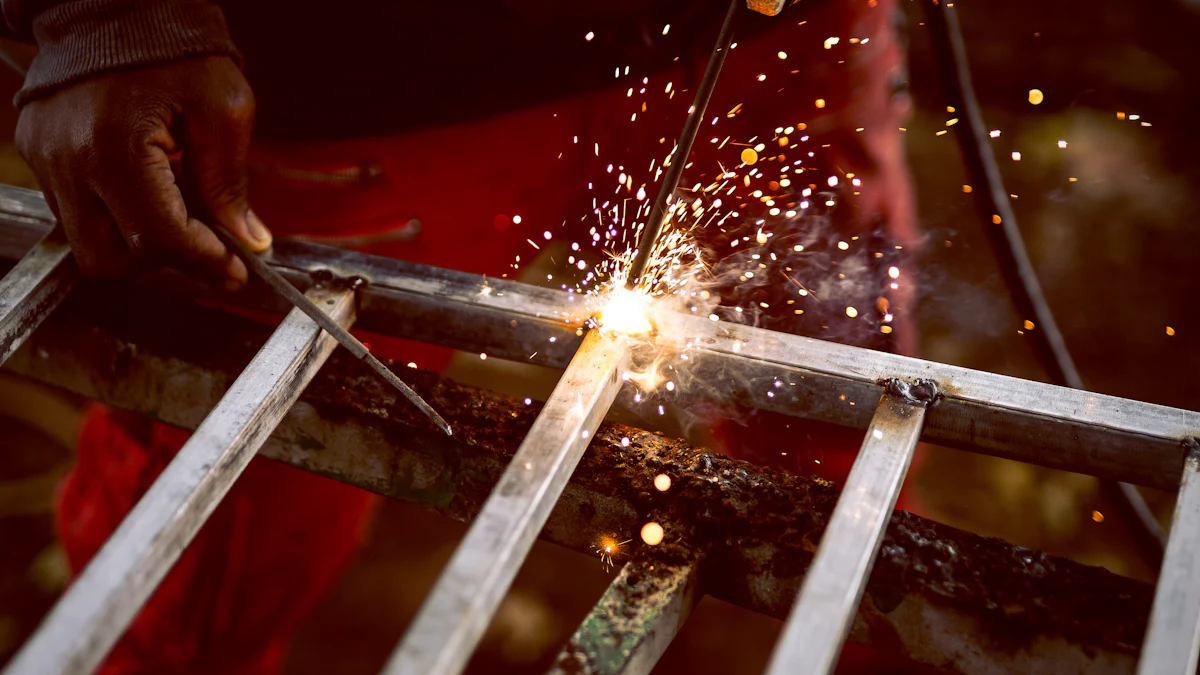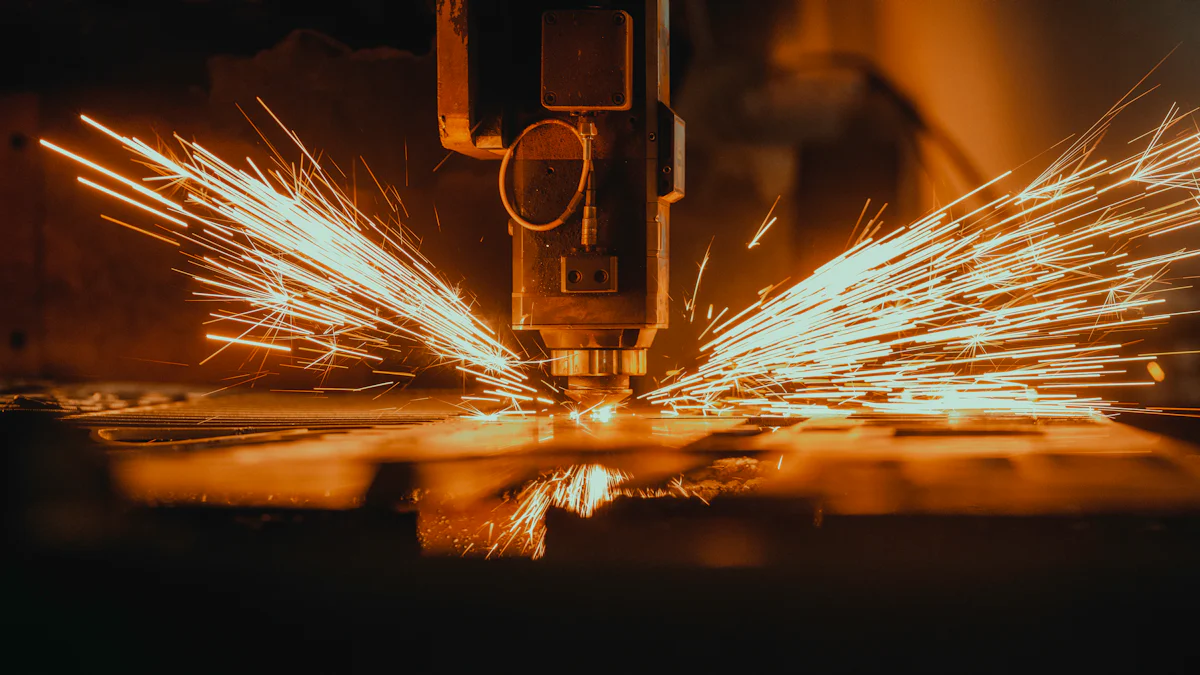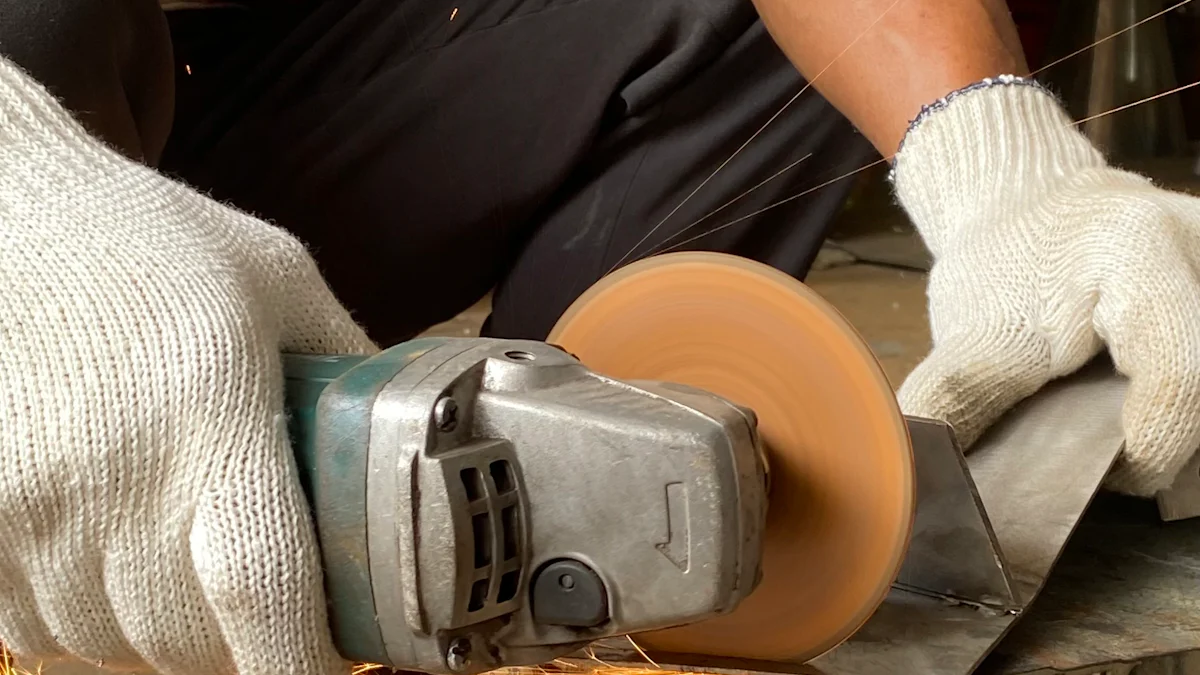How Do Machines Cut Metal as Thin as Paper

Have you ever asked yourself, "How do machines cut metal as thin as paper?" It’s not magic—it’s the result of precision engineering at its peak. These machines utilize advanced tools and cutting-edge techniques to slice through even the toughest materials with remarkable accuracy. By analyzing the unique properties of metals, such as their hardness and flexibility, engineers develop systems capable of making these incredibly delicate cuts. Industries like aerospace and electronics heavily depend on this technology to produce lightweight components and intricate designs. With the growing need for such innovations, the global market for these machines is expected to expand at a 5.2% annual growth rate from 2023 to 2030.
Key Takeaways
- Precision engineering is essential for cutting metal as thin as paper, ensuring that machines operate with accuracy and consistency.
- Understanding material properties, such as hardness and flexibility, is crucial for selecting the right cutting method and achieving clean cuts.
- Regular calibration of cutting machines is vital to maintain accuracy and prevent costly errors in production.
- Different cutting techniques, like die cutting, laser cutting, and waterjet cutting, each have unique advantages depending on the material and desired precision.
- Adjusting machine settings, including speed and pressure, is key to preventing material damage and ensuring high-quality cuts.
- Industries such as electronics and aerospace rely on the ability to cut thin metals for lightweight components and intricate designs, driving innovation.
- Artists and crafters can leverage precision cutting technology to create detailed and custom designs, enhancing their creative projects.
The Science Behind Cutting Metal as Thin as Paper
Understanding Material Properties
Thickness and flexibility of metal vs. paper
When you compare metal to paper, the differences in thickness and flexibility become obvious. Paper, being lightweight and pliable, bends easily without breaking. Metal, on the other hand, varies widely in thickness and rigidity depending on its type. For instance, aluminum sheets are more flexible than steel, but both require precise tools to achieve cuts as thin as paper.
The challenge lies in controlling the cutting process to match the material's properties. If the metal is too thick or rigid, it resists the cutting force, leading to uneven edges. Conversely, if the metal is thin and flexible, it may warp or tear during cutting. Machines designed for this task must account for these factors to ensure clean, accurate results.
How material hardness affects cutting techniques
Material hardness plays a critical role in determining the cutting method. Harder metals, like titanium or stainless steel, demand tools made from materials with superior hardness, such as tungsten carbide or diamond coatings. These tools resist wear and maintain their sharpness even under extreme conditions.
Cutting speed and pressure also depend on hardness. Softer metals allow faster cutting speeds, while harder metals require slower, more deliberate cuts to prevent tool damage. Engineers carefully calibrate these parameters to achieve precision without compromising the tool's lifespan. As research highlights, the cutting tool must always be harder than the material being cut to perform effectively.
The Role of Precision Engineering
Importance of accuracy in machine design
Precision engineering ensures that machines can handle the intricate task of cutting metal as thin as paper. Every component of the machine, from its blades to its motors, must work in harmony to deliver consistent results. Even the slightest misalignment can lead to errors, making accuracy a top priority in machine design.
Modern machines use advanced technologies like computer numerical control (CNC) systems to enhance precision. These systems allow you to program exact measurements, ensuring that every cut meets the desired specifications. This level of accuracy is essential for industries like aerospace and electronics, where even minor deviations can lead to significant issues.
How tolerances are maintained during cutting
Maintaining tolerances during cutting is no small feat. Tolerances refer to the allowable deviation from the specified dimensions, and in precision cutting, these deviations are often measured in microns. Machines achieve this by using sensors and feedback systems to monitor the cutting process in real time.
For example, if the machine detects a variation in pressure or speed, it adjusts automatically to stay within the set tolerances. This ensures that each cut is as precise as the last, regardless of the material's properties. By combining robust design with real-time adjustments, these machines consistently deliver high-quality results.
Tools and Techniques for Cutting Thin Metal and Paper

When it comes to cutting metal as thin as paper, the tools and techniques used play a crucial role. Each method offers unique advantages, depending on the material and the level of precision required. Let’s dive into some of the most effective methods.
Die Cutting Machines
How die cutting works for metal and paper
Die cutting machines are versatile tools that can cut precise shapes from materials like metal and paper. These machines use a metal die, which is a shaped cutting tool, to press into the material and create clean, uniform cuts. For paper, the process is straightforward because of its flexibility. However, cutting metal requires more force and specialized dies to handle the material's rigidity.
You’ll often find die cutting machines in industries like crafting and manufacturing. They’re compact enough to fit on a workspace yet powerful enough to handle tougher materials. By layering the material with a metal shim or adapter plate, you can ensure the die cuts through completely. This technique is especially useful when working with intricate designs or thicker sheets of metal.
Types of dies used for precision cutting
The type of die you use determines the quality and precision of the cut. Steel-rule dies are ideal for cutting thicker materials like metal. They feature sharp, durable edges that can withstand repeated use. On the other hand, thin metal dies are better suited for delicate cuts and intricate patterns, making them perfect for thinner materials.
For best results, you should always match the die type to the material. Using the wrong die can lead to incomplete cuts or damage to the material. With the right setup, die cutting machines can produce flawless results, whether you’re working with paper or metal.
Laser Cutting Technology
How lasers achieve high precision
Laser cutting technology uses a high-power laser beam to slice through materials with incredible accuracy. The laser focuses intense energy on the material’s surface, causing it to melt, vaporize, or undergo chemical reactions. This process creates clean, precise edges without physical contact, reducing the risk of material distortion.
You’ll notice that laser cutting is particularly effective for thin metals and intricate designs. The beam’s precision allows you to create detailed patterns that traditional cutting methods can’t achieve. Industries like aerospace and electronics rely heavily on laser cutting for components that demand high levels of detail and accuracy.
Advantages of laser cutting for thin materials
Laser cutting offers several benefits when working with thin materials. First, it minimizes material waste by creating precise cuts with little to no excess. Second, it operates at high speeds, making it an efficient choice for large-scale production. Finally, the non-contact nature of laser cutting ensures that delicate materials, like thin metal sheets, remain undamaged during the process.
This method is also highly adaptable. Whether you’re cutting aluminum for lightweight components or stainless steel for durability, laser cutting delivers consistent results. Its versatility and efficiency make it a go-to option for industries requiring precision and speed.
Waterjet Cutting
How waterjets cut through metal and paper
Waterjet cutting uses a high-pressure jet of water, sometimes mixed with abrasives, to slice through materials. The water stream moves at incredible speeds, exerting enough force to cut through even the toughest metals. Unlike laser cutting, waterjet cutting doesn’t rely on heat, making it ideal for materials sensitive to high temperatures.
For thin metals and paper, waterjets provide a clean and accurate cut. The process works by directing the water stream along the desired cutting path, ensuring precision. You can use this method for a wide range of materials, from soft paper to thick steel plates.
Benefits of waterjet cutting for delicate materials
One of the biggest advantages of waterjet cutting is its ability to cut without generating heat. This eliminates the risk of heat-related damage, such as warping or discoloration, which is especially important for delicate materials. Additionally, waterjet cutting produces smooth edges, reducing the need for secondary finishing.
Another benefit is its versatility. Whether you’re working with thin sheets of metal or intricate paper designs, waterjet cutting delivers reliable results. It’s a popular choice for industries that prioritize accuracy and material integrity, such as aerospace and art.
By understanding these tools and techniques, you can see how machines achieve the precision needed to cut metal as thin as paper. Each method has its strengths, allowing you to choose the best approach for your specific needs.
Machine Settings and Adjustments for Precision Cutting
Precision cutting relies heavily on the correct machine settings and adjustments. Without proper calibration and fine-tuning, even the most advanced tools can fail to deliver accurate results. Let’s explore how you can optimize your machine for consistent and high-quality cuts.
Importance of Calibration
How calibration ensures consistent results
Calibration is the backbone of precision cutting. It ensures that your machine operates at peak performance by aligning its components and settings to the required specifications. Over time, wear and tear can cause deviations in your machine’s accuracy. Regular calibration helps you catch these issues early, preventing costly errors and maintaining consistent results.
For example, CNC machines require precise calibration to ensure their cutting tools follow the programmed paths without deviation. By fine-tuning the machine’s axes and verifying its measurements, you can achieve cuts that meet exact tolerances. This process not only improves the quality of your work but also extends the lifespan of your equipment.
Pro Tip: Always schedule regular calibration checks. Consistency in calibration leads to consistency in results.
Tools used for machine calibration
To calibrate your machine effectively, you’ll need the right tools. Basic calibration often involves using micrometers, dial indicators, and gauge blocks to measure and adjust the machine’s settings. For more advanced needs, tools like laser interferometers and three-plane laser systems come into play. These devices provide highly accurate measurements, detecting even the smallest deviations in the machine’s axes.
Qualified technicians often use these advanced tools to ensure your machine meets the highest standards of precision. By investing in proper calibration equipment or hiring skilled professionals, you can safeguard the accuracy of your cutting processes.
Speed and Pressure Settings
How speed affects cutting quality
The speed of your machine plays a critical role in determining the quality of the cut. If the cutting speed is too high, it can lead to rough edges or incomplete cuts. On the other hand, a speed that’s too slow might cause overheating or unnecessary wear on the cutting tool. Finding the right balance is key.
For instance, when cutting thin metal sheets, a moderate speed allows the tool to maintain control and precision. Faster speeds might work for softer materials like paper, but metals require a more deliberate approach to avoid errors. Adjusting the speed based on the material ensures clean and accurate cuts every time.
Adjusting pressure for different materials
Pressure settings are just as important as speed. The amount of force applied during cutting must match the material’s properties. Thin metals, for example, need less pressure compared to thicker or harder metals. Too much pressure can warp or damage delicate materials, while too little pressure might result in incomplete cuts.
Modern machines often include adjustable pressure settings, allowing you to fine-tune the force applied. By experimenting with these settings and monitoring the results, you can find the optimal pressure for each material. This adjustment not only improves the quality of your cuts but also reduces wear on your tools.
Quick Tip: Always test your speed and pressure settings on a sample piece before starting a full project. This saves time and prevents material waste.
By mastering calibration, speed, and pressure adjustments, you can unlock the full potential of your cutting machine. Whether you’re working with thin metal or paper, these settings ensure precision and consistency, helping you achieve professional-grade results.
Applications of Cutting Metal as Thin as Paper

The ability to cut metal as thin as paper has transformed industries, enabling innovations that were once unimaginable. From electronics to aerospace and even art, this precision technology plays a vital role in shaping the modern world. Let’s explore how it impacts different fields.
Electronics Industry
Use of thin metal sheets in circuit boards
In the electronics industry, thin metal sheets are essential for creating circuit boards. These boards act as the backbone of electronic devices, connecting components like resistors and capacitors. Thin metals, such as copper, are used because they conduct electricity efficiently while maintaining a lightweight structure. Machines capable of cutting metal with extreme precision ensure that these sheets meet the exact specifications required for high-performance devices.
The use of thin metals in electronics dates back to early advancements in metal fabrication. Ancient civilizations laid the groundwork for today’s techniques by developing tools to manipulate metals. This evolution has allowed modern engineers to create intricate designs that power everything from smartphones to medical devices.
Precision requirements for electronic components
Precision is non-negotiable when it comes to electronic components. Even the slightest deviation in a circuit board’s design can lead to malfunctioning devices. Machines designed for cutting metal as thin as paper ensure that every detail is accurate, down to the micron level. This level of precision supports the production of reliable and efficient electronics.
For example, microchips require thin metal layers to function correctly. These layers must be uniform and free of defects to ensure optimal performance. By using advanced cutting techniques, manufacturers can meet these stringent requirements, paving the way for smaller, faster, and more powerful devices.
Aerospace and Automotive Industries
Lightweight materials for improved performance
In aerospace and automotive industries, lightweight materials are crucial for enhancing performance. Thin metal sheets reduce the overall weight of vehicles and aircraft, improving fuel efficiency and speed. Aluminum and titanium are popular choices due to their strength-to-weight ratio, and machines capable of precise cutting make it possible to use these materials effectively.
The concept of using lightweight metals isn’t new. Ancient civilizations used metal tools to improve efficiency in their daily lives. Today, this idea has evolved into cutting-edge technology that allows engineers to design vehicles capable of reaching incredible speeds while consuming less energy.
Role of thin metal in structural components
Thin metal sheets also play a significant role in structural components. In aerospace, they’re used to create fuselage panels and wing structures that must withstand extreme conditions. In automotive manufacturing, thin metals are used for body panels and frames, ensuring durability without adding unnecessary weight.
Precision cutting ensures that these components fit together seamlessly, enhancing safety and performance. By achieving cuts as thin as paper, manufacturers can create intricate designs that maximize strength while minimizing material usage. This balance is essential for meeting the demands of modern transportation.
Art and Craft Applications
Decorative uses of thin metal and paper
Thin metal and paper have found their way into the world of art and crafts, offering endless possibilities for creativity. Artists use thin metal sheets to create intricate sculptures, jewelry, and decorative pieces. The ability to cut metal with precision allows for detailed designs that were once impossible to achieve.
For example, die cutting machines enable artists to craft delicate patterns from thin metal and paper. These tools provide the accuracy needed to bring complex ideas to life, whether it’s a decorative wall hanging or a custom piece of jewelry. The versatility of these materials makes them a favorite among creators.
Custom designs using die cutting machines
Die cutting machines have revolutionized the art and craft world by making custom designs accessible to everyone. Whether you’re a professional artist or a hobbyist, these machines allow you to experiment with thin metal and paper to create unique projects. From wedding invitations to personalized gifts, the possibilities are endless.
By layering materials and using specialized dies, you can achieve clean, precise cuts that elevate your creations. This technology not only saves time but also ensures consistent results, making it easier to bring your vision to life. With the right tools, you can turn thin metal and paper into works of art.
The applications of cutting metal as thin as paper extend far beyond what meets the eye. Whether you’re building the next generation of electronics, designing lightweight vehicles, or creating stunning art, this technology opens up a world of possibilities. It’s fascinating to see how ancient techniques have evolved into modern innovations, shaping industries and inspiring creativity.
Machines have revolutionized the way we approach precision cutting, enabling you to cut metal as thin as paper with remarkable accuracy. Tools like die cutting machines, laser cutters, and waterjet systems showcase how advanced technology meets material science to achieve this feat. These methods not only enhance efficiency but also open doors to innovation across industries. From electronics to aerospace, the ability to work with thin metals has transformed manufacturing and design. As technology evolves, advancements like fiber lasers and robotic plasma cutting promise even greater precision, efficiency, and sustainability in the future.
FAQ
What is the best way to cut metal?
The best method for cutting metal depends on your specific needs. Factors like the type of metal, its thickness, and the desired precision all play a role. For intricate designs or thin sheets, laser cutting offers unmatched accuracy. If you’re working with heat-sensitive materials, waterjet cutting is a great option. Die cutting machines are ideal for repetitive shapes and patterns. Always consider efficiency, precision, and safety when choosing your method.
Can you cut metal as thin as paper at home?
Cutting metal as thin as paper at home is possible, but it requires the right tools. Manual die cutters or small-scale laser cutters can handle thin metals for DIY projects. However, achieving professional-grade precision might be challenging without industrial equipment. If you’re new to this, start with simple designs and practice on scrap materials to refine your technique.
What tools are essential for precision cutting?
For precision cutting, you’ll need tools like die cutting machines, laser cutters, or waterjet systems. Each tool serves a specific purpose. For example, laser cutters excel at detailed patterns, while waterjets are perfect for delicate materials. Calibration tools like micrometers and gauge blocks are also essential to maintain accuracy. Investing in high-quality tools ensures better results and extends the lifespan of your equipment.
How do you prevent material damage during cutting?
To avoid damaging your material, adjust your machine’s settings carefully. Use the correct speed and pressure for the material you’re cutting. For thin metals, lower pressure reduces the risk of warping. If you’re using a die cutting machine, ensure the die is sharp and properly aligned. Testing on a sample piece before starting your project can help you fine-tune your settings.
Why is calibration important for cutting machines?
Calibration ensures your cutting machine operates with precision. Over time, wear and tear can cause misalignments, leading to inaccurate cuts. Regular calibration aligns the machine’s components and settings to their original specifications. This not only improves the quality of your cuts but also extends the life of your equipment. Think of calibration as routine maintenance for consistent performance.
What’s the difference between laser cutting and waterjet cutting?
Laser cutting uses a focused beam of light to slice through materials, offering high precision and speed. It’s ideal for intricate designs and thin metals. Waterjet cutting, on the other hand, uses a high-pressure stream of water mixed with abrasives. This method doesn’t generate heat, making it perfect for materials sensitive to high temperatures. Both methods have unique advantages depending on your project’s requirements.
Can die cutting machines handle both metal and paper?
Yes, die cutting machines can cut both metal and paper. However, the process differs slightly. Cutting metal requires more force and specialized dies, while paper is easier to work with. Using a metal shim or adapter plate can improve the cut quality for metal. Always choose the right die for the material to achieve clean and precise results.
How do you choose the right cutting method for your project?
Choosing the right cutting method depends on your material and design needs. For detailed patterns, laser cutting is a top choice. If you’re working with heat-sensitive materials, waterjet cutting is better. Die cutting machines are great for repetitive shapes. Consider factors like material thickness, precision requirements, and budget to make the best decision.
What industries benefit most from precision cutting?
Precision cutting plays a vital role in industries like electronics, aerospace, and art. In electronics, thin metal sheets are used for circuit boards and microchips. Aerospace relies on lightweight, precisely cut materials for improved performance. Artists and crafters use precision cutting for intricate designs and custom creations. This technology has transformed how these industries operate, enabling innovation and creativity.
Are there any safety tips for using cutting machines?
Safety should always come first when using cutting machines. Wear protective gear like gloves and goggles. Keep your workspace organized to avoid accidents. Follow the manufacturer’s guidelines for operating your machine. Regularly inspect your tools for wear and tear. By staying cautious and prepared, you can ensure a safe and efficient cutting process.
